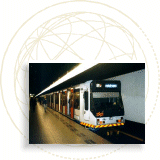home | nieuws | projecten | www-links | bibliotheek | vraag het RCM
| Paris - RATP
History In 1998, the Régie Autonome des Transports Parisiens (RATP) plans to open her new METEOR line in the heart of Paris. The first phase of this project will be a new 7.6 kilometres of track, seven stations and a number of new pneumatic-tired trains. The trains will operate with initial intervals of 105 seconds, later dropping to 85 seconds. The METEOR line is intended to be (as the RATP calls it) a model line for the year 2000. In July 1900, the first metro line of Paris opened its first line over a track of 10 kilometres. By 1913, the system had rapidly expanded to 91 kilometres of track and in 1930 it had grown to 110 kilometres with configuration in central Paris which is roughly the same as it is today. The development of the system slowed down considerably between 1930 and 1939 and even came to a complete stop with the outbreak of World War II. In 1945 and 1946, the metro system was under considerable strain. Buses were slowly coming back into service and the Paris metro established a historic record by transporting 1.6 billion people in 1946. Between 1945 and 1965, the network stayed pretty much the same, with only innovations in the rolling stock. Four metro lines in Paris were equipped with tired wheels. The economic boom of the 1960's resulted in a new era of system growth and equipment modernisation. Some existing lines were extended and two centre lines were joined together. All metro vehicles were completely renovated and new electronic, computer and telecommunication technologies were introduced. As in London (and New York), public safety and crime prevention became an important issue in the 1980's. The metro management was facing exploding crime rates for two decades and finally had the means to do something against it. |
|||||||
|
|||||||
Source: López, M.J.J., Crime Prevention Guidelines for the Construction & Management of Metro Systems, Den Haag: RCM-advies 1996, pg. 19-20. |

 One hundred years ago, the city of Paris had grown to a population
of 2.8 million inhabitants facing a quick growth of traffic and
associated problems of congestion, pollution and environmental
deterioration. To cope with these problems, an underground metro
line was constructed in 1900 and rapidly extended over the following
years. Today, the Parisian Ile-de-France region inhabits a total
of 10.7 million people and produces 28% of France's national
output. The metro system has expanded to 368 stations and 15 underground
lines (including 2 short lines) with a length of 201 kilometres
of track. There are 3,500 cars which transport roughly 6 million
passengers a day.
One hundred years ago, the city of Paris had grown to a population
of 2.8 million inhabitants facing a quick growth of traffic and
associated problems of congestion, pollution and environmental
deterioration. To cope with these problems, an underground metro
line was constructed in 1900 and rapidly extended over the following
years. Today, the Parisian Ile-de-France region inhabits a total
of 10.7 million people and produces 28% of France's national
output. The metro system has expanded to 368 stations and 15 underground
lines (including 2 short lines) with a length of 201 kilometres
of track. There are 3,500 cars which transport roughly 6 million
passengers a day. Order
this book
Order
this book